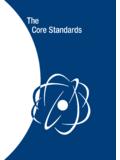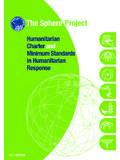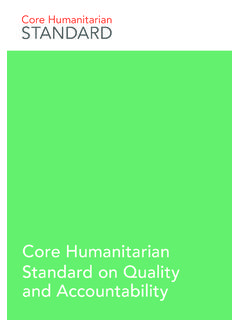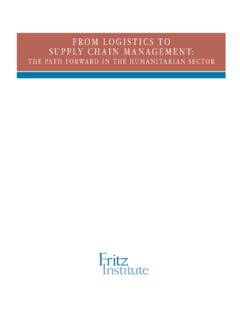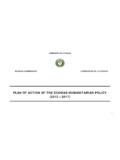Transcription of E Economic and Social Council - UNICEF
1 United Nations E/ICEF/2017/18. Economic and Social Council Distr.: General 17 July 2017. English Original: English/French/Spanish For information United Nations Children's Fund Executive Board Second regular session 2017. 12-15 September 2017. Item 4 of the provisional agenda . Final results framework of the UNICEF Strategic Plan, 2018-2021.. E/ICEF/2017/14. 17-14158X (E) 170817. *1714158*. E/ICEF/2017/18. Contents Page Abbreviations 3. I. The Strategic Plan, 2018-2021 results architecture 5. II. Features of the results framework 5. A. UNICEF contribution to the 2030 Agenda for Sustainable Developmen t 5. B. Monitoring organizational efficiency and effectiveness 7. C. Equity 7. D. Gender equality 7.
2 E. Humanitarian action 8. F. United Nations working together 8. III. Impact level, Goal Area level (outcome) and results area level (output) indicators 9. A. Goal Area 1: Every child survives and thrives 9. B. Goal Area 2: Every child learns 20. C. Goal Area 3: Every child is protected from violence and exploitation 27. D. Goal Area 4: Every child lives in a safe and clean environment 32. E. Goal Area 5: Every child has an equitable chance in life 37. IV. Change strategies (HOW) 42. V. Organizational effectiveness and efficiency (ENABLERS) 49. Humanitarian Annex 54. 2/57. E/ICEF/2017/18. Abbreviations ART antiretroviral therapy BEmONC basic emergency obstetric and newborn care BIA/BID best interests assessment/best interests determination C4D communication for development CPD country programme document CPMP country programme management plan DTP/penta 3 diphtheria/tetanus/pertussis pentavalent vaccine ECD early childhood development EMIS Education Management Information System FAO Food and Agriculture Organization of the United Nations FGM/C female genital mutilation/cutting Global Fund The Global Fund to Fights AIDS.
3 Tuberculosis and Malaria GPI gender parity index GVAP Global Vaccine Action Plan HACT harmonized approach to cash transfers HMIS Health Management Information System HPV human papilloma virus HTC HIV testing and counselling ICT information and communications technology IDP internally displaced person ILO International Labour Organization IP International Professional ITN insecticide-treated net KPI key performance indicator MOPAN Multilateral Organisation Performance Assessment Network NEET not in employment, education or training OMP office management plan ORE other resources (emergency). ORR other resources (regular). ORS oral rehydration solution PCV pneumococcal conjugate vaccine 3/57.
4 E/ICEF/2017/18. QCPR quadrennial comprehensive policy review of operational activities for development of the United Nations system RBB results-based budgeting RBM results-based management RR regular resources SAM severe acute malnutrition SDGs Sustainable Development Goals SOP standard operating procedures UIS UNESCO Institute for Statistics UNAIDS Joint United Nations Programme on HIV/AIDS. UNCT United Nations country team UNDAF United Nations Development Assistance Framework UNDP United Nations Development Programme UNESCO United Nations Educational, Scientific and Cultural Organization UNFPA United Nations Population Fund UNGEI United Nations Girls' Education Initiative UNHCR Office of the United Nations High Commissioner for Refugees UNODC United Nations Office on Drugs and Crime UNV United Nations Volunteers UN-Women United Nations Entity for Gender Equality and the Empowerment of Women WASH water, sanitation and hygiene WFP World Food Programme WHO World Health Organization 4/57.
5 E/ICEF/2017/18. I. The Strategic Plan, 2018-2021 results architecture 1. The Strategic Plan describes the results to be achieved by UNICEF and key partners by 2021 in the context of the 2030 Agenda for Sustainable Development (the WHAT). It also describes the change strategies necessary for the achievement of results (the HOW). and the internal factors that support the change strategies and the achievement of results (the ENABLERS). See the figure below on the Strategic Plan results logic. Figure: Strategic Plan Results Architecture II. Features of the results framework 2. Several factors have shaped the definition of the results framework. These include the following: A. UNICEF contribution to the 2030 Agenda for Sustainable Development 3.
6 The results framework of the Strategic Plan incorporates the impact, outcome and output indicators necessary for monitoring progress. These have been identified on the basis of the UNICEF mandate and comparative advantage in the 2030 Agenda in relation to United Nations entities. While impact- and outcome-level results reflect the combined efforts of Governments, United Nations entities, the private sector, civil society and other partners, output-level results reflect the specific contribution of UNICEF to the 2030. Agenda. 5/57. E/ICEF/2017/18. Impact and outcome-level results 4. Global milestones and targets are presented for impact indicators on the basis of the Sustainable Development Goals or related global strategies.
7 UNICEF will contribute to these high-level changes across all countries, consistent with the principle of universality in the 2030 Agenda through its global influence in the generation and dissemination of evidence, advocacy and campaigns, normative work and the shaping of markets for children, in combination with its more direct contribution in countries where it has a programme. Outcome-level results are also identified on the basis of the Sustainable Development Goal targets but in relation to countries where UNICEF has a programme in support of national priorities. These link more closely to output-level results. Computation of milestones and targets 5. Impact-level results reflect the 2030 Sustainable Development Goal targets or related strategies for all countries.
8 Outcome-level targets also reflect 2030 Sustainable Development Goal targets and/or related strategies but in relation to countries in which UNICEF has a programme. The 2021 milestones for impact- and outcome-level changes are derived on the basis of the annual rate of progress required to meet the global Sustainable Development Goal or related target by 2030, where such numeric targets exist. For indicators with non-numeric targets, 2021 milestones have been set on the basis of the observed achievable increase from available trend data. Milestones and targets for output- level changes are derived from planned programmes at the country level. Output-level results 6. For each of the five Goal Areas (outcomes), UNICEF has identified a number of outputs that require the organization's leadership and contribution to outcome-level change and by extension to the related Sustainable Development Goal targets.
9 In developing the outputs, UNICEF sought to formulate results for which it has the mandate and comparative advantage. 7. The output-level results and indicators capture the full range of support that UNICEF . provides in various country contexts (including in humanitarian situations), such as direct service provision, systems strengthening, policy processes and normative work, advocacy, and various types of support related to positive changes in Social norms. The main focus is on the change in the capacities of countries for at-scale results for children. 8. This approach to output formulation is based on a lesson learned from implementation of the Strategic Plan, 2014-2017, where it was not always easy to track the various types of contributions that UNICEF made.
10 The approach also responds to a recommendation made in the Evaluability Assessment of the Strategic Plan on strengthening the design and application of the plan as a framework that guides the development and implementation of nationally owned country programmes, rather than using the results framework as a strict log frame. Monitoring the implementation of the change strategies 9. The results framework further outlines the eight change strategies (the HOW) for the achievement of results under the five Goal Areas. The change strategies are guided by the quadrennial comprehensive policy review of operational activities for development of the United Nations system (QCPR). UNICEF delivers change by combining high-quality programmes at scale, using gender-responsive programming and harnessing innovation and collecting evidence, in partnership with Governments, other United Nations partners, civil society, the private sector, communities and children.










